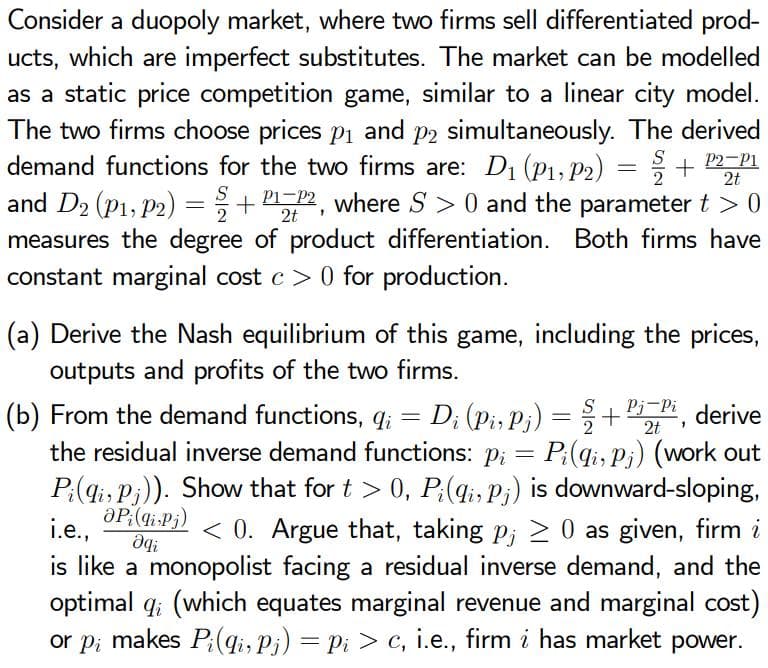Consider a duopoly market, where two firms sell differentiated prod- ucts, which are imperfect substitutes. The market can be modelled as a static price competition game, similar to a linear city model. The two firms choose prices pi and p2 simultaneously. The derived demand functions for the two firms are: D1 (P1, P2) = ; + and D2 (p1, P2) =+2, where S> 0 and the parameter t >0 measures the degree of product differentiation. Both firms have constant marginal cost c > 0 for production. P2-P1 2t S (a) Derive the Nash equilibrium of this game, including the prices, outputs and profits of the two firms. (b) From the demand functions, q; = D; (pi, P;) = + ", derive the residual inverse demand functions: p; = P;(qi, P¡) (work out P:(qi, P;)). Show that for t > 0, P;(q;, P;) is downward-sloping, < 0. Argue that, taking p; 20 as given, firm i is like a monopolist facing a residual inverse demand, and the optimal q; (which equates marginal revenue and marginal cost) or p; makes P:(qi, p;) = pi > c, i.e., firm i has market power. Pj-Pi i.e., !be
Consider a duopoly market, where two firms sell differentiated prod- ucts, which are imperfect substitutes. The market can be modelled as a static price competition game, similar to a linear city model. The two firms choose prices pi and p2 simultaneously. The derived demand functions for the two firms are: D1 (P1, P2) = ; + and D2 (p1, P2) =+2, where S> 0 and the parameter t >0 measures the degree of product differentiation. Both firms have constant marginal cost c > 0 for production. P2-P1 2t S (a) Derive the Nash equilibrium of this game, including the prices, outputs and profits of the two firms. (b) From the demand functions, q; = D; (pi, P;) = + ", derive the residual inverse demand functions: p; = P;(qi, P¡) (work out P:(qi, P;)). Show that for t > 0, P;(q;, P;) is downward-sloping, < 0. Argue that, taking p; 20 as given, firm i is like a monopolist facing a residual inverse demand, and the optimal q; (which equates marginal revenue and marginal cost) or p; makes P:(qi, p;) = pi > c, i.e., firm i has market power. Pj-Pi i.e., !be
Managerial Economics: Applications, Strategies and Tactics (MindTap Course List)
14th Edition
ISBN:9781305506381
Author:James R. McGuigan, R. Charles Moyer, Frederick H.deB. Harris
Publisher:James R. McGuigan, R. Charles Moyer, Frederick H.deB. Harris
Chapter12: Price And Output Determination: Oligopoly
Section: Chapter Questions
Problem 1E
Related questions
Question

Transcribed Image Text:Consider a duopoly market, where two firms sell differentiated prod-
ucts, which are imperfect substitutes. The market can be modelled
as a static price competition game, similar to a linear city model.
The two firms choose prices p1 and p2 simultaneously. The derived
demand functions for the two firms are: D1 (P1, P2) = ; +
and D2 (P1, P2) =+ 2, where S > 0 and the parameter t > 0
measures the degree of product differentiation. Both firms have
constant marginal cost c > 0 for production.
S
P2-P1
2t
S
(a) Derive the Nash equilibrium of this game, including the prices,
outputs and profits of the two firms.
Pj-Pi derive
(b) From the demand functions, q; = D; (pi, Pj) =
the residual inverse demand functions: p; = P;(qi, Pi) (work out
P:(qi, Pi)). Show that for t > 0, P:(q;, P;) is downward-sloping,
aP:(gi-Pj)
+
2t
i.e.,
< 0. Argue that, taking p; > 0 as given, firm i
is like a monopolist facing a residual inverse demand, and the
optimal q; (which equates marginal revenue and marginal cost)
or pi makes P;(qi, P¡) = Pi > c, i.e., firm i has market power.
Expert Solution
This question has been solved!
Explore an expertly crafted, step-by-step solution for a thorough understanding of key concepts.
This is a popular solution!
Trending now
This is a popular solution!
Step by step
Solved in 3 steps

Knowledge Booster
Learn more about
Need a deep-dive on the concept behind this application? Look no further. Learn more about this topic, economics and related others by exploring similar questions and additional content below.Recommended textbooks for you

Managerial Economics: Applications, Strategies an…
Economics
ISBN:
9781305506381
Author:
James R. McGuigan, R. Charles Moyer, Frederick H.deB. Harris
Publisher:
Cengage Learning



Managerial Economics: Applications, Strategies an…
Economics
ISBN:
9781305506381
Author:
James R. McGuigan, R. Charles Moyer, Frederick H.deB. Harris
Publisher:
Cengage Learning



Exploring Economics
Economics
ISBN:
9781544336329
Author:
Robert L. Sexton
Publisher:
SAGE Publications, Inc

Managerial Economics: A Problem Solving Approach
Economics
ISBN:
9781337106665
Author:
Luke M. Froeb, Brian T. McCann, Michael R. Ward, Mike Shor
Publisher:
Cengage Learning